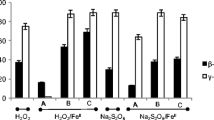Summary
A commercial wettable-powder formulation (50% a. i.) of hexachlorocyclohexane (HCH) was applied to unplanted and planted (to rice) soils under flooded and non-flooded conditions at 1 kg a. i. ha−1 at 15-day intervals. A mineral salts medium supplemented with γ-HCH as a sole source of C was inoculated with suspensions from HCH-treated and untreated soils (unplanted or planted to rice) and incubated under aerobic conditions. γ-HCH disappeared completely within 10 days from the aerobically incubated medium inoculated with the suspension from the treated soil compared to less than 30% loss from the uninoculated medium or from the medium inoculated with the suspension from the untreated soil, during the corresponding period. Soil samples from HCH-treated flooded pots lost their capacity for accelerated degradation of γ-HCH after autoclaving. The addition of HCH clearly stimulated aerobic degradation of γ-HCH, even in predominantly anaerobic flooded soil. The factor responsible for the accelerated degradation of γ-HCH in pretreated soil was not detected in the deeper layers (>10 cm) of flooded soil and in fields that had dried following the rice harvest.
Similar content being viewed by others
References
Adhya TK, Sethunathan N (1990) Leaching of hexachlorocyclohexane isomers under planted and unplanted conditions in a flooded rice field. In: Frehse H, Kesseir-Schmitz E, Conway S (eds) Proc. 7th Int. Congress of Pesticide Chemistry, vol 3. IUPAC, Hamburg, p 156
Anonymous (1989) Production of pesticides. Pestic Inf 14:28–29
Araragi M, Tangcham B, Cholitkul W, Phetchawee S (1979) Studies on microflora of tropical paddy and upland farm soils. Tech Bull 13, Trop Agric Res Center, Japan
Brahmaprakash GP, Reddy BR, Sethunathan N (1985) Persistence of hexachlorocyclohexane isomers in soils planted with rice and in rice rhizosphere soil suspensions. Biol Fertil Soils 1:103–109
Felsot AS (1989) Enhanced biodegradation of insecticides in soil: Implications for agroecosystems. Annu Rev Entomol 34:453–476
Felsot AS, Maddox JV Bruce W (1981) Enhanced microbial degradation of carbofuran in soils with histories of Furadan use. Bull Environ Contam Toxicol 26:781–788
Harris CR, Chapman RA, Harris C, Tu CM (1984) Biodegradation of pesticides in soil: Rapid induction of carbamate degrading factors after carbofuran treatment. J Environ Sci Health 19 B:1–11
Karns JS, Mulbry WW, Nelson JC, Kearney PC (1986) Metabolism of carbofuran by a pure bacterial culture. Pestic Biochem Physiol 25:211–217
MacRae IC, Raghu K, Castro TF (1967) Persistence and biodegradation of four isomers of benzenehexachloride in submerged soils. J Agric Food Chem 15:911–916
MacRae IC, Raghu K, Bautista EM (1969) Anaerobic degradation of the insecticide lindane by Clostridium sp. Nature (London) 221:859–860
Ohisa N, Yamaguchi M (1978) Degradation of γ-HCH in flooded soils enriched with peptone. Agric Biol Chem 42:1983–1987
Ponnamperuma FN (1972) The chemistry of submerged soils. Adv Agron 24:29–96
Racke KD, Coats JR (1988) Enhanced degradation and the comparative fate of carbamate insecticides in soil. J Agric Food Chem 36:1067–1072
Rajagopal BS, Brahmaprakash GP, Reddy BR, Singh UD, Sethunathan N (1984) Effect and persistence of selected carbamate pesticides in soil. Residue Rev 93:1–199
Ramakrishna C, Sethunathan N (1982) Stimulation of autotrophic ammonium oxidation in rice rhizosphere soil by the insecticide carbofuran. Appl Environ Microbiol 44:1–4
Read DC (1983) Enhanced microbial degradation of carbofuran and fensulfothion after repeated applications to acid mineral soil. Agric Ecosyst Environ 10:37–46
Read DC (1986) Accelerated microbial breakdown of carbofuran in soil from previously treated fields. Agric Ecosyst Environ 15:51–61
Sahu SK, Patnaik KK, Sethunathan N (1990) Degradation of α-, β- and γ-isomers of hexachlorocyclohexane by rhizosphere soil suspension from sugarcane. Proc Indian Acad Sci (Plant Sci) 100:165–172
Sethunathan N (1971) Biodegradation of diazinon in paddy fields as a cause of its inefficiency for controlling brown planthoppers in rice fields. Pestic Articles News Summaries 17:18–19
Sethunathan N, Pathak MD (1972) Increased biological hydrolysis of diazinon after repeated applications in rice paddies. J Agric Food Chem 20:586–589
Sethunathan N, Rao VR, Adhya TK, Raghu K (1983) Microbiology of rice soils. CRC Crit Rev Microbiol 10:125–172
Wada H, Senoo K, Takai Y (1989) Rapid degradation of γ-HCH in upland soil after multiple applications. Soil Sci Plant Nutr 35:71–77
Author information
Authors and Affiliations
Rights and permissions
About this article
Cite this article
Bhuyan, S., Sahu, S.K., Adhya, T.K. et al. Accelerated aerobic degradation of γ-hexachlorocyclohexane in suspensions of flooded and non-flooded soils pretreated with hexachlorocyclohexane. Biol Fertil Soils 12, 279–284 (1992). https://doi.org/10.1007/BF00336044
Received:
Issue Date:
DOI: https://doi.org/10.1007/BF00336044




